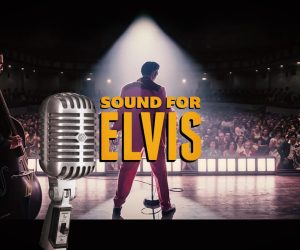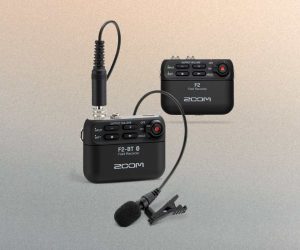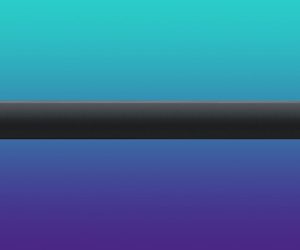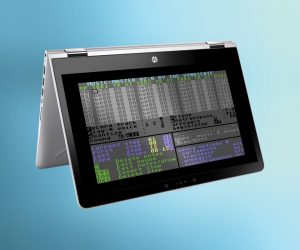
Wade Wilson: Hollywood Sound Designer
From The Perfect Storm to Shrek with The Simpsons somewhere between, Oscar-nominated Wade Wilson knows a thing or two about big-budget film sound.
Text: Derek Johnson
As much as music can make a movie, film soundtracks would almost be nothing without sound effects. The way most films are made these days means that location sound and the actual sounds made by everyday objects (and events) are either not ‘real enough’ or may be drowned out by unwanted ambience.
This is doubly the case with action, fantasy and, especially, animated films. Think of the hyper-real sound of the water and storm in Wolfgang Petersen’s 2000 true-life adventure The Perfect Storm, or all the lava, explosions and silliness in 2001’s street-wise computer animated classic Shrek… Wherever CGI (Computer Generated Imagery) rears its head, sound designers follow.
EARLY DAYS
As it happens, I recently had a contributor to the sound world of these two mega-grossing movies on the other end of a trans-Pacific phone call. I caught up with Wade after a grueling day at the office – he’d just returned from completing the first temp mix for the next Wolfgang Petersen blockbuster – Poseidon, the remake of 1972’s disaster epic The Poseidon Adventure. “The studio executives will be viewing it and we’ll get notes on our work.”
The Perfect Storm was actually Wade’s debut in movies, but it wasn’t his first sound design job. That said, he’d only been in the business a couple of years, but his move into the profession was rather auspicious, via Matt Groening’s long-running animated TV series The Simpsons. This really was one of those ‘right place, right time’ moments: “I was actually doing drum programming on the Synclavier. It turns out that Travis Powers, who had been doing sound effects for The Simpsons since the series started, also used the Synclavier.” Powers is on record as saying that he’s kept every sound he ever created for the show – a logical and necessary move, but also one that means he’s managing a big library of sounds. (He is also on record as using a Midi guitar to trigger sound effects from his Synclavier!)
So, around 1997, Wade was brought in by Powers to learn and help administer the massive Simpsons sound library. This was also a time when professionals were starting to move from Synclavier to other ways to manage sound effects – in this case the new platform was Digidesign’s ProTools. Wade helped with the move for both the Simpsons’ library and that for Matt Groening’s next series, Futurama. From there, Wade moved into sound design proper on both shows. The late ’90s saw a mini explosion in prime-time animated programming aimed at grown-ups perhaps more than children. As a result, Wade branched out to do sound on The PJs (a short-lived show starring Eddie Murphy) and Dilbert, developed from the long-running comic strip.
Having got his feet wet in TV, Wade “decided I’d rather get into the feature film side of things.” But he didn’t wait for the work to come to him: “I approached Soundelux [they’re a significant player in large budget feature film sound design] in early 1999. I talked to (company co-founder) Wylie Stateman about getting an assignment for one of his films, and he gave me the job of doing the weather for The Perfect Storm.”
Talk about jumping in at the deep end! How did you go about getting sounds for that movie – by recording the weather? “Oh yeah, I recorded a lot of stuff, and not just weather. For example, I went out and recorded specific locations on the coast I knew where I could get a certain sound of water hitting rock at low tide. We’d then go into the studio and blend the real sounds with dozens of other sounds from a library and our own special recordings of cannons and geysers and all kinds of stuff in order to create the water. For the wind, I used the Midi keyboard on my Synclavier to pitch and bend sounds – the Synclavier’s technology does this without too much aliasing.”
Synclavier was Wade’s preferred platform, but the writing was on the wall as indicated by his experience on The Simpsons: “It’s been gradually phased out. The problem is that it’s so expensive to keep up to date and serviced. ProTools is running such a close second now with some of the tools they offer. It’s not all-in-one box yet, but it’s close.”
Whether Wade sources sounds from scratch or refers to existing libraries depends on budget. “We do have libraries that we can use to develop a soundtrack. But we’ll generally tend to go out with hard disk recorders and record new sounds, just for that punchiness or to get an edge, depending on what we’re working on.
“There are going to be projects that don’t have the budget to go out and record a set of new sounds. In that case we’ll do our best to find something the director feels comfortable with in our libraries. Generally, they’re pretty accepting of what we find because they know there are constraints to the budget. But for the most part, when it’s an A-list feature, the director wants new stuff, so we go out and get it.”


HARD DRIVE ON THE ROAD
And that new stuff is sourced with a compact Edirol R4 four-track portable hard disk recorder (www.edirol.com), which comes with a 40GB hard drive, on-board editing controls, and records at 24-bit/96k resolution: “I bought it on the recommendation of a friend who works at the pro audio desk of my local music store. And it sounds really good! It has a couple of great built-in stereo mics, which I find are great for recording table reads [where the cast do a preliminary read-through of the script] and simple stuff like that, and it has four phantom-powered inputs for any kind of mic or line source that you could ever want.
“It’s turned out to be a really nice piece of gear. And it’s straightforward to use: just connect it up with USB 2.0 and drop audio straight into a Mac!”
The R4 occasionally follows Wade around when he’s not working on a film: “I do like to bring it on the road with me just in case there’s something cool to record. My wife would prefer me to leave it behind, but it somehow makes it into the car!”
But sound design isn’t all about field trips. At some stage, the audio goes to work and most projects will start in Wade’s home studio. “The configuration here is just ideal, and I load my work onto removable Firewire drives which make moving sounds from studio to studio easy. I have an open mic in my soundstage at home that I can use to record directly into ProTools – I can even work on creature voices that might be an element under bigger, scarier things.” Wade is a member of the Screen Actors Guild, so his voice can end up, somewhere, on the soundtrack of a finished film.
“Also, my monitoring is set up just the way I like it.”
I enjoy working on animated projects the most. You get to create a new world from beginning to end
MONITORING
Mentioning monitoring brings up an interesting issue: that of working on sound for feature films across a variety of studios. Just how do you keep the sound – or more correctly, your perception of the sound – consistent? Wade is an early adopter of JBL LSR Series monitors and his current pair of LSR6328Ps (in tandem with the LSR6312SP sub bass unit) provide the answer: “I take a set with me in road cases.”
As much as it might make sense to use one set of monitors in different studio situations, there is one thing you can’t take with you and that’s the exact configuration of room and space that you’re used to in your own studio. But these LSRs have an ace up their sleeve: RMC (Room Mode Correction) circuitry. RMC is designed to eliminate the effect of low frequency room modes, which can cause boominess and related inaccuracies in the low end of a mix (for more on RMC and the new LSRs check out our review later in this issue).
“The LSR remote control setup has been just fabulous for me because I do a lot of work out of my house and I do a lot of work in dubbing studios,” noted Wade. “I really appreciate having the uniformity in sound when moving between those different work environments. When I take my work to the dub stage, I don’t have to waste time EQ’ing things out of a monitor mix to try to fix the low end. The RMC just seems to produce a truer mix when I get to the stage with much less effort. I’d also say that 80–90% of the big theatres where we screen our films in Los Angeles have the JBL ScreenArray cinema sound system in them. So I find that my work is translating all the way from sound design to film project, which is great.”
As an aside, Wade notes that not all cinemas are equal, in spite of the popularity of the ScreenArray system. The audio track is not always the way he remembers it from when he was working on his sound designs: “The sound is usually accurate, but there are some times when I’d like to get up and have a word with the manager! I’ll hear the left channel coming in and out, information that should be fed into the right channel will come into the centre channel and what should be in the centre channel is now coming out right rear. There is definitely room for improvement.”
Back to monitoring: DSP-based methods of fixing room problems are generally thought to produce side-effects – listening fatigue, a skewed impression of what’s being monitored and so on – but that’s not been Wade’s experience: “I haven’t noticed any fatigue on my ear at all and we often use this system in small work spaces. During dubbing you’ll walk out of an 8 x 8-foot room full of noisy ProTools fans onto the dub stage, and you’ll try to hear things translate from one room to the other.” Sounds as if the transition could be aurally challenging in its own right! “But it just seems that the translation from one environment to the next, with the LSRs, is true to what you want to hear.”
But what about waiting for the system to actually do the calibration – surely it takes ages to set up a new room? “It takes less than half an hour, because I’ve been using them for so long. It looks as if the new 4300 Series will do the job even faster.” There are two monitors in the new series, both with the RMC circuitry built in and a calibration mic included in the box: they’re more compact than the 6300s Wade already uses, but this shouldn’t be a problem “because the rooms I work in are usually small enough that I don’t have to worry about high SPLs.”

SOUND DESIGN FOR LIVING
When you check out Wade’s CV (have a look at his Internet Movie Database entry: www.imdb.com!), you may wonder, as I did, what exactly it is he does. Credits list him as ‘sound designer’, ‘sound effects editor’ and so on and these seem like distinct jobs. “It varies from show to show, because each show requires a different set of skills. I guess it all falls under the auspices of The Motion Pictures Editors guild [the well-established and venerable umbrella organisation for post production professionals – www.editorsguild.com], as a sound editor but most of what I do is but typically sound design.”
Life can be solitary, especially when a project has a lower budget, but “on projects like Poseidon, there’s gotta be half a dozen sound designers working on it. There really is so much CGI in comparison to a standard live action feature and everything, including sound, has to be created from scratch. It’s very much like working on an animated film in a sense.”
At some point, the sound effects have to be married to the dialogue and music tracks. I wondered when the contact with the other sound professionals happens. “That’s when the sound mix comes into view, when we all sit in a room and weave the sound palette together so that whatever needs to be speaking to us at a given moment in the film is addressed. All we’re doing is helping to tell a story by supporting what’s happening on screen. The sonic elements which do that best are given precedence, whether we’re examining a single sonic event, a whisper from the lead actress, or a music cue… we spend as much time as possible addressing those key moments, so we can take the movie audience on a ride.”
ANIMATED RESPONSE
Wade has worked on prime-time animated TV, and a wide range of CGI-heavy (and CGI-only) movies as well as more laid back fare, yet “I enjoy working on animated projects the most. You get to create a new world from beginning to end. There’s nothing there, to start with, but a blank palette: everything, from the backgrounds up, has to be designed.” And favourite job so far? “I’d have to say it’s Shrek – from beginning to end, it was just such a pleasure.”
And what about a favourite sound effect? The response was almost instantaneous: “My favourite sound that I created is hard to listen out for because it gets turned down a lot, but when the lava explodes in the lava moat surrounding the castle in Shrek… for me, that’s the best moment of sound design in the film! Especially when Donkey says something about being over a fire-breathing moat and you hear it. But I understand why it’s low in the mix… you don’t want to scare the children!”
















RESPONSES